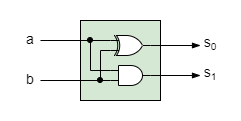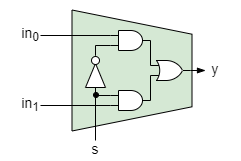Applications 3: Diferență între versiuni
Fără descriere a modificării |
Fără descriere a modificării |
||
| Linia 63: | Linia 63: | ||
''block of instructions''<br /> | ''block of instructions''<br /> | ||
'''end''' | '''end''' | ||
For combinational circuits the safest way to declare the sensitivity list is to use the wildcard ('''*'''). | |||
It stands for all variables that appear on RHS expressions and in evaluation expressions. | |||
<syntaxhighlight lang="Verilog"> | |||
always @(*) begin | |||
if(s) | |||
c = in[1]; | |||
else | |||
c = in[0]; | |||
end | |||
</syntaxhighlight> | |||
== Exercise 3 == | == Exercise 3 == | ||
Versiunea de la data 4 martie 2019 21:12
Behavioral descriptions, continuous assignment, conditional instructions, use of blocks always for describing combinational circuits.
Structural descriptions, logic gates, verilog gate primitives.
Exercise 1
gate-level description of the 1-bit half adder
Use data flow description (a simpler kind of behavioral description that uses logic expressions). Logic expressions employ only logic operators.
| operator | function |
|---|---|
| ~ | not |
| & | and |
| | | or |
| ^ | xor |
One assign instruction for each output. Concurrent assignments.
assign c[0] = a ^ b;
assign c[1] = a & b;
Use gate-level description (a structural description with gate primitives). Verilog gate primitives: not, and, nand, or, nor, xor and xnor. Except for the not gate, all other primitive gates may have 2, 3 or more inputs.
They are all instantiated using the same template: gate primitive myGate(outputWire, inputWire1, inputWire2 ...) as in the following examples:
not g1(dout, din); is a not gate with dout at output and din connected at its input.
nand g2(dout, d1, d2); is a nand gate with dout at output and two wires, d1 and d2, connected to its inputs.
nand g3(dout, d1, d2, d3, d4); is a nand gate with dout at output and for inputs, connected to d1, d2, d3 and d4.
Using gate primitives, a possible structural description of the half-adder may be:
xor g1(c[0], a, b);
and g2(c[1], a, b);
Write a simple testbench for the half-adder and simulate both descriptions, data-flow and gate-level with primitives.
Exercise 2
2 to 1 multiplexer, behavioral description
always block. Used for behavioral descriptions. Template:
always @(sensitivity list) begin
block of instructions
end
For combinational circuits the safest way to declare the sensitivity list is to use the wildcard (*). It stands for all variables that appear on RHS expressions and in evaluation expressions.
always @(*) begin
if(s)
c = in[1];
else
c = in[0];
end
Exercise 3
The same 2 to 1 multiplexer, described at the gate level
Exercise 4
4 to 1 multiplexer
case instruction. Selects between multiple cases. Template
case(selectVariable)
value1 : instruction block 1
value2 : instruction block 2
a.s.o.
endcase
value1, value2 a.s.o. are integer values of the selectVariable
case(s)
0: c = in[0];
1: c = in[1];
2: c = in[2];
3: c = in[3];
endcase




